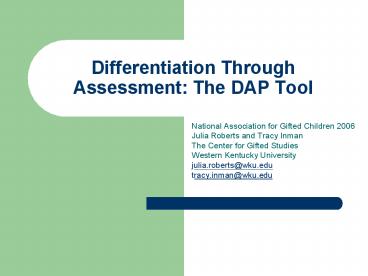Differentiation Through Assessment: The DAP Tool - PowerPoint PPT Presentation
1 / 12
Title:
Differentiation Through Assessment: The DAP Tool
Description:
Differentiation Through Assessment: The DAP Tool. National ... distinguishes one diorama of a rainforest biome from another diorama of a rainforest biome. ... – PowerPoint PPT presentation
Number of Views:532
Avg rating:3.0/5.0
Title: Differentiation Through Assessment: The DAP Tool
1
Differentiation Through Assessment The DAP Tool
- National Association for Gifted Children 2006
- Julia Roberts and Tracy Inman
- The Center for Gifted Studies
- Western Kentucky University
- julia.roberts_at_wku.edu
- tracy.inman_at_wku.edu
2
Teachers Can Differentiate...
- CONTENT
- What do you want the students to know?
- PROCESS
- What do you want the students to do cognitively
with what they know? - PRODUCT
- How can students demonstrate what theyve
learned? - ASSESSMENT
- How do you assess what has been learned?
3
Differentiating Assessment
- Many educators hesitate holding students
accountable at varying levels, perhaps unsure of
their ability to be consistent and equitable. The
DAP Tool is an instrument that greatly encourages
appropriate differentiation of assessment.
4
Developing and Assessing Product Tool (DAP Tool)
- Assessment is all about learning the
professional educator looks for evidence of
continuous progress. Evidence that this
continuous progress occurs is multifaceted.
5
Components of DAP Tool
- Content
- Presentation
- Creativity
- Reflection
6
Content
- The meat of the product, the content, must be
accurate and organized. And in order to preserve
your sanity, the language must be general enough
so that the product can be applied in all content
areas. The student is responsible for being
content specific. - Is the content accurate?
- Is the content well organized?
7
Presentation
- This component will be more unique in wording
than the other three because the descriptors will
be specific to the product itself. When
developing multi-level rubrics for the same
product, language becomes much more sophisticated
in this section. The main question for this area
follows - Are product specific components included in the
presentation?
8
Creativity
- Creativity, that personal spark or insight that
inspires the student, surfaces in both the
content (distinct viewpoint) and presentation
(unique approach). Its originality. Its what
distinguishes one diorama of a rainforest biome
from another diorama of a rainforest biome. The
following two questions form the basis of the
creativity component - How does that personal insight relate to the
content? - How does that personal spark relate to the
presentation?
9
Reflection
- This component, highly personal in nature,
consists of the students reflecting on her
learning. Reflections include what she has
learned, how she has learned, and how beneficial
the learning experience was. The following two
questions with support for their answers form
the basis of the reflection component - What did you learn about the content as you
completed this product? - What did you learn about yourself as a learner by
creating this product?
10
Developing and Assessing Product Tool (DAP Tool)
Rating Scale
- 6 EXPERT LEVEL level expected from a
professional in the content area - 5 ADVANCED LEVEL level exceeds expectations of
the standard - 4 PROFICIENT LEVEL level expected for meeting
the standard - 3 PROGRESSING LEVEL level demonstrates
movement toward the standard - 2 NOVICE LEVEL level demonstrates initial
awareness and knowledge of standard - 1 NON-PERFORMING LEVEL level indicates no
effort made to reach the standard
11
DAP Tool Levels 1, 2, and 3
- Kindergartners can create posters just as seniors
in high school can create posters. Should the
scoring guide be the same for both? Isnt a
poster a poster? - Although the criteria may be the same in the
rubrics, the level of sophistication should vary
greatly!
12
Levels Become More Sophisticated
- More specific wording at different levels of
sophistication guides the young person as she
works on the product, and it also provides the
guidelines for your assessing the product when it
is completed. - Because of your preassessment, you know that
expectations need to be different for some
students. This is where multiple DAP Tools for
the same product come into play. The main
variation will be the upping of expectations,
greater sophistication of wording.































